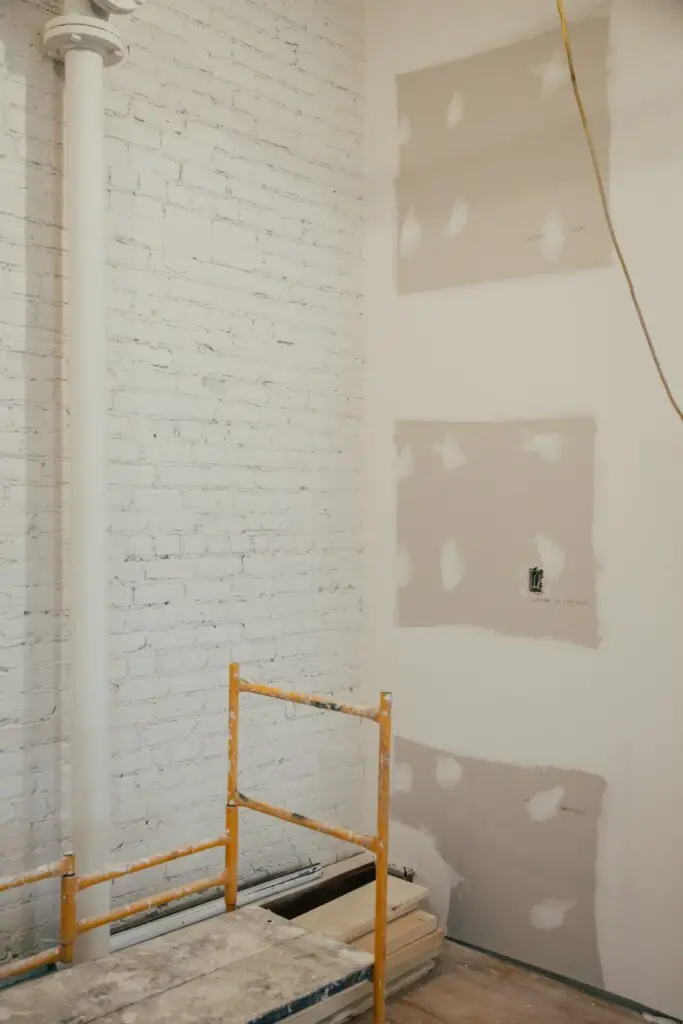Painting a ceiling or wall is an easy way to refresh a room. But, how many coats of paint do you need?
In general, you will need one coat of primer and two coats of paint for most surfaces. However, you may need more coats of the new color if the surface is textured, if you are painting light over dark, if you are painting dark over light, or if you are painting porous surfaces.
In this post, we’ll go over each scenario so you can be prepared for any situation you may have.
Table of Contents
How Many Coats of Paint on the Ceiling?

There are a lot of factors that go into how many coats of paint you should use on a ceiling, so we’ve broken it down into four sections.
We’ll first talk about if you’re painting on a flat ceiling that has old paint similar to the new paint color.
Then, we’ll talk about what to do if you’re painting over a textured ceiling or a ceiling that’s a darker color or a lighter color than the new paint color.
Well, we’re not going to get anything done sitting around here, so let’s get into it.
Flat Ceiling of Similar Color
This is probably the most common scenario. If you’re painting on a flat ceiling and you’re using a new color that’s similar to the old color, then one coat of primer and two coats of paint should be enough.
Make sure you let the paint completely dry before you decide if your paint is enough. Once it’s dry you might be able to see places you missed.
A general rule of thumb is if it looks evenly painted and completely covered after it’s dried, then you’re good to go.
You should give your ceiling a once-over after every coat of paint has dried. Although two coats will usually be enough, how much paint you need will depend on the quality of the paint and how evenly it was painted.
Textured Ceiling
A textured ceiling, such as a popcorn ceiling, can take a little more to paint than just a flat ceiling.
There are paint rollers that are specifically made for painting textured ceilings. These rollers are extra thick so they can get in every crevice.
If you use these special rollers and high-quality paint, you should only need one coat of primer and two coats of paint.
However, if you use a regular paint roller you might unevenly coat your ceiling which means you need to paint it more than twice.
You may think you can save money by using a regular roller, but you’ll end up needing more paint than if you got the thicker roller which evens out the cost.
Light Paint Over Dark Paint
The biggest difference in wall color you could have would be trying to put white paint on a black ceiling. Putting on a coat of primer will help seal in the dark paint color.
Normally, you only need one coat of primer. But, on a super dark color, using two coats of primer can make sure that dark color doesn’t bleed through as much.
After you’ve put on your primer, start with two coats of paint. After the second coat of paint has dried, take a look at the ceiling to check if any of the old color is bleeding through. If it is, add another coat.
You can add as many coats of paint as you need until the old dark color isn’t bleeding through anymore.
Dark Paint Over Light Paint
A light color painted darker is much easier than the opposite. For this scenario, you should only need one coat of primer and two coats of new paint.
But, the number of coats you’ll need will depend on the quality of your paint and how evenly is it painted on. High-quality paints will need fewer coats of paint.
The benefit of painting dark on light is it’s much easier to tell if there are small spots you missed. Wait until the paint has dried and check for any missed spots.
As always, if you need another coat, put on another coat. There is no limit to how many coats of paint you can put on.
How Many Coats of Paint on a Wall?

Painting a wall is very similar to painting a ceiling so the same rules apply.
A textured wall is not as common as a textured ceiling but it could happen. If you have a textured wall, follow the same guidance as for a textured ceiling above.
Before you paint your wall, you’ll want to make sure there are no holes in the wall. If there are, you’ll want to spackle over the hole. You can find a tutorial on how to seal holes in walls in our other post here.
The general rule of thumb for painting walls is one coat of primer and two coats of paint. You may need more depending on the color difference between the paints.
Below, we’ll talk about how to handle two common wall painting scenarios. Now let’s get into the action.
Light Paint Over Dark Paint
To put light paint over dark paint, you’ll want to paint enough so that the darker color is no longer bleeding through.
Most of the time, you only need to use one coat of primer when painting. But, because of the color difference, it might be helpful to put on two coats of primer.
This will give you a lighter base to start with which will help with the finished color.
After the primer, you will need at least two coats of paint to fully cover the old color. Once the two coats have dried, take a look at the wall and see if the color is what you want.
If the dark color is still bleeding through slightly, add another coat of paint. Continue until you’re happy with the finished product.
Dark Paint Over Light Paint
Putting dark colors over lighter colors is much easier than the other way around. Light paint will not bleed through as much as dark.
For this, you only need one coat of primer. Then, paint on two coats of your new dark color.
Two coats should be sufficient for the wall, but after the paint has dried, look at your wall to see if any spots of light color are poking through.
Painting dark over light makes it easy to tell if there are places that are not fully covered.
If you need another coat, don’t skimp. You won’t need to paint that wall again for a long time so do it right the first time.
How Many Coats of Paint on New Drywall?

You’ve got a brand new wall to paint woohoo!! The benefits to this are you don’t have to worry about covering up an old color.
But, drywall has paper on the outside which needs to be fully saturated to have a good finish. To ensure an even finish over drywall, you need one coat of primer and at least two coats of paint.
If you don’t put on one coat of primer and two coats of paint, some of the texture from the paper on the drywall will stick through leaving rough patches on your wall.
Take a look at the new wall once the paint has dried, and check the wall for any uneven spots. Using a light, flashlight on your phone will work, and holding it at an angle to the wall can help you check for any rough patches left by the drywall paper.
Depending on the quality of your paint, you may need more than two coats, but you should never use less even if the paint says it only needs one coat.
How Many Coats of Paint on Unfinished Wood?

You’re most likely to run into this situation with unfinished wood furniture or trim. Finishing wood floors is a whole other process.
If you’re wondering about finishing hardwood floors, check out HGTV’s article about it.
Before you paint your wood, you’ll need to make sure it’s smooth. I recommend sanding the whole surface with 200-grit sandpaper or above.
Once you have a smoother surface, wipe any remaining sawdust off with a dry rag. Repeat wiping it down until no dust remains.
For best results, I recommend putting on a sanding sealer before your first coat of paint. Sanding sealer helps seal the pores of the raw wood which makes a smoother finish and makes it so you don’t have to use as much paint.
Now that the wood is prepped, time for the paint.
As with everything else, one primer coat and two coats of paint should do it. If you used a sanding sealer, that acts like a primer, but if not, a paint primer can work as well.
Once your paint is dry, check to see if your unfinished wood has the desired look. Add more coats of paint as needed.
Related Questions
How Long Should Paint Dry Before You Add Another Coat?
How long between coats depends on the type of paint. If you use water-based paints/latex paint, it needs to dry about two hours before the next coat. For oil-based paint, it can take up to 24 hours to dry. Check the can of your paint for what the manufacturer recommends as the dry time between coats.
Should You Paint the Ceiling First or Last?
It’s a better idea to paint the ceiling first. It’s easier to cut in the edges of a wall than of a ceiling and ceiling paint could drip down or splatter on the wall while you paint. For those reasons, you should paint the ceiling first.
Should You Sand Between Coats of Paint?
Usually, you do not need to sand between coats of paint. The only time you would need to sand between coats of paint is if your paint tells you to or between a coat of sanding sealer and a top coat when painting unfinished wood. Check the manufacturer’s recommendation for your specific paint brand for more guidance.
